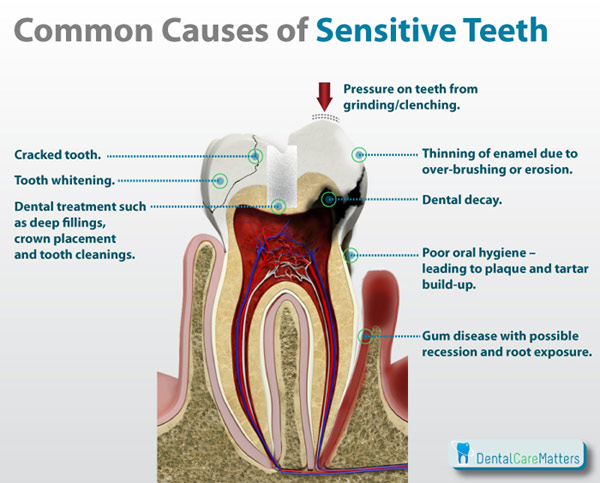What goes through your mind when your teeth hurt (other than whether or not all of that Valentine’s Day candy is worth it)? Is it fleeting or constant? Are you easily agitated by hot and cold stimuli alike? Do you have problems even when you brush and/or floss? These are some of the circumstances those with sensitive teeth have.
Now you would think this is pretty straightforward, right? Your teeth hurt, you stop doing what is making them hurt, and you go to get them evaluated. Unfortunately, it’s never that simple. Sensitive teeth can be a precursor to disease developing, or it can be a symptom of disease that’s established. Examples of causes of sensitive teeth include the following.
- Cavities (holes in the teeth)
- Decayed and/or fractured teeth
- Exposure of the tooth root or nerve endings supplying the teeth
- Gum disease
- Worn tooth enamel or fillings

A common thread exists in the above listing. Enamel protects healthy teeth at the level of your crowns—the part above the gum line. Cementum protects the tooth root (which lies below the gum line). Underneath both the enamel and the cementum is dentin, a layer of the teeth less dense and more hollow. When the levels of protective covering are eroded and dentin is exposed, foods and other substances may penetrate and reach the nerves within your teeth through these more hollow areas. The increased propensity for this to happen is experienced as hypersensitivity.
Your first challenge is not to let things get out of control. In the event you’re experiencing dental pain for any reason, it needs to be evaluated and addressed. If it’s truly hypersensitivity, your dentist has several options at his or her disposal.
- Desensitizing toothpaste contains compounds that help block transmission of sensation from the tooth surface to the nerve. Several applications are usually required before the sensitivity is sufficiently lessened.
- Fluoride gel can be applied in the dentist’s office. This serves to strengthen tooth enamel.
- Placement of a crown, inlay or bonding may be used to correct a flaw or decay that results in sensitivity.
- If gum tissue has been lost from the root, a surgical gum graft will protect the root and reduce sensitivity.
- If sensitivity is severe and persistent and cannot be treated by other means, your dentist may recommend a root canal to eliminate the problem.
Feel free to ask your SMA expert consultant any questions you may have on this topic.
Order your copy of Dr. Sterling’s new book Behind The Curtain: A Peek at Life from within the ER at jeffreysterlingbooks.com, iTunes, Amazon, Barnes and Nobles and wherever books are sold.
Thanks for liking and following Straight, No Chaser! This public service provides a sample of what http://www.SterlingMedicalAdvice.com (SMA) and 844-SMA-TALK offers. Please share our page with your friends on WordPress, like us on Facebook @ SterlingMedicalAdvice.com and follow us on Twitter at @asksterlingmd.
Copyright © 2016 · Sterling Initiatives, LLC · Powered by WordPress



